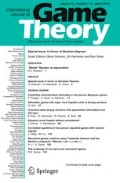Abstract.
The Nash equilibrium solution concept for games is based on the assumption of expected utility maximization. Reference dependent utility functions (in which utility is determined not only by an outcome, but also by the relationship of the outcome to a reference point) are a better predictor of behavior than expected utility. In particular, loss aversion is an important element of such utility functions.
We extend games to include loss aversion characteristics of the players. We define two types of loss-aversion equilibrium, a solution concept endogenizing reference points. The two types reflect different procedures of updating reference points during the game. Reference points emerge as expressions of anticipation which are fulfilled.
We show existence of myopic loss-aversion equilibrium for any extended game, and compare it to Nash equilibrium. Comparative statics show that an increase in loss aversion of one player can affect her and other players' payoffs in different directions.
Similar content being viewed by others
Author information
Authors and Affiliations
Additional information
Received August 1998/Revised version February 2000
Rights and permissions
About this article
Cite this article
Shalev, J. Loss aversion equilibrium. Game Theory 29, 269–287 (2000). https://doi.org/10.1007/s001820000038
Issue Date:
DOI: https://doi.org/10.1007/s001820000038



